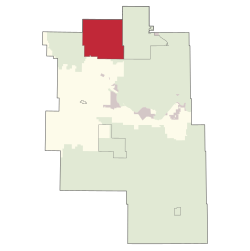Peavine Metis Settlement is a Metis settlement in northern Alberta, Canada within Big Lakes County.[3] It is located on Highway 750 to the northeast of High Prairie.
Peavine Metis Settlement | |
|---|---|
Metis Settlement | |
 Location within Big Lakes County | |
Location within Alberta | |
| Coordinates: 55°51′N 116°16′W / 55.850°N 116.267°W | |
| Country | Canada |
| Province | Alberta |
| Region | Northern Alberta |
| Census division | 17 |
| Government | |
| • Chair | Kenneth Noskey |
| • Governing body | Peavine Metis Council |
| Area (2021)[2] | |
| • Land | 328.42 km2 (126.80 sq mi) |
| Population (2021)[2] | |
• Total | 310 |
| • Density | 0.9/km2 (2/sq mi) |
| Time zone | UTC−7 (MST) |
| • Summer (DST) | UTC−6 (MDT) |
| Peavine Metis Settlement | |
Demographics
editIn the 2021 Census of Population conducted by Statistics Canada, Peavine had a population of 387 living in 150 of its 201 total private dwellings, a change of -36.2% from its 2016 population of 607. With a land area of 798.95 km2 (308.48 sq mi), it had a population density of 0.5/km2 (1.3/sq mi) in 2021.[2]
The population of the Peavine Metis Settlement according to its 2018 municipal census is 566,[4] a decrease from its 2015 municipal census population count of 639.[5]
As a designated place in the 2016 Census of Population conducted by Statistics Canada, the Peavine Metis Settlement had a population of 607 living in 192 of its 284 total private dwellings, a change of -12% from its 2011 population of 690. With a land area of 816.38 km2 (315.21 sq mi), it had a population density of 0.7/km2 (1.9/sq mi) in 2016.[6]
See also
editReferences
edit- ^ "Municipal Officials Search". Alberta Municipal Affairs. May 9, 2019. Retrieved October 1, 2021.
- ^ a b c "Population and dwelling counts: Canada and designated places". Statistics Canada. February 9, 2022. Retrieved February 10, 2022.
- ^ "Specialized and Rural Municipalities and Their Communities" (PDF). Alberta Municipal Affairs. 2012-11-05. Retrieved 2012-11-20.
- ^ 2019 Municipal Affairs Population List (PDF). Alberta Municipal Affairs. December 2019. ISBN 978-1-4601-4623-1. Retrieved September 28, 2021.
- ^ 2016 Municipal Affairs Population List (PDF). Alberta Municipal Affairs. ISBN 978-1-4601-3127-5. Retrieved September 28, 2021.
- ^ "Population and dwelling counts, for Canada, provinces and territories, and designated places, 2016 and 2011 censuses – 100% data (Alberta)". Statistics Canada. February 8, 2017. Retrieved February 9, 2017.
External links
edit
